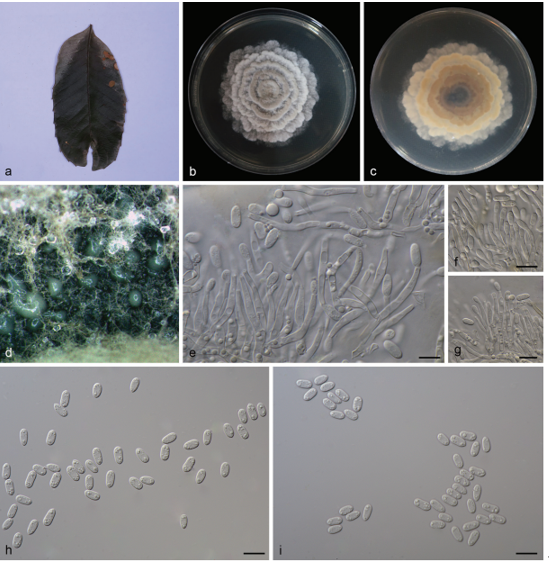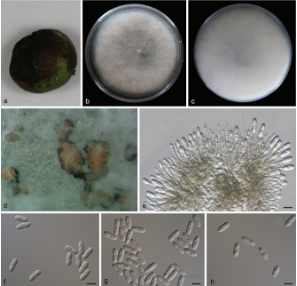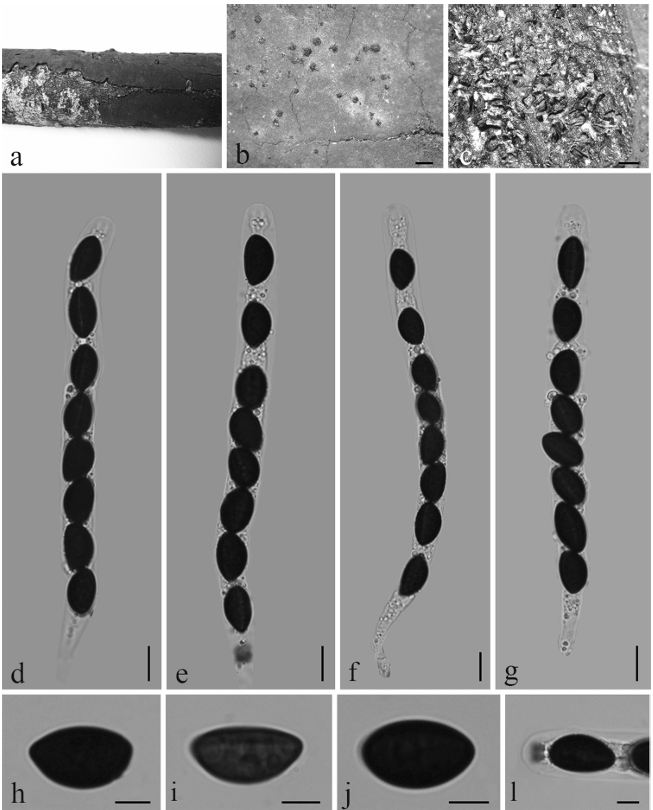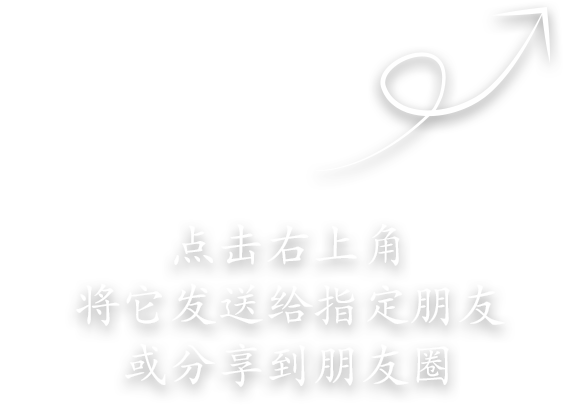Neokalmusia kunmingensis H.B. Jiang, Phookamsak & K.D. Hyde 2020
Index Fungorum number: IF555422; Facesoffungi number: FoF 05081
Holotype: CHINA, Yunnan Province, Kunming, Golden Temple, on dead bamboo culms, 5 December 2017, H.B. Jiang & R. Phookamsak, GT002 (KUN-HKAS 101765, holotype), ex-type living culture KUMCC 18-0120.
Morphological description
Sexual morph Ascostromata 0.5–5 mm diam., 170–300 μm high, scattered or in groups, immersed under a black clypeuslike structure, dark brown to black, multi-loculate. Locules 280–370 μm diam., 175–290 μm high, immersed within ascostromata, dark brown to black, subglobose to ampulliform, ostiolate. Peridium 13–23 μm broad, comprising several layers; outer layers dark brown to brown, compressed cells of textura angularis; inner layers hyaline compressed pseudoparenchymatous cells, arranged in textura angularis. Hamathecium composed of 1.2–2 μm broad, septate, branched, anastomosing, filiform, hyaline, pseudoparaphyses. Asci 63–77 × 9.6–11.4 μm ( x̄ = 70 × 10.5 μm, n = 20), 8-spored, bitunicate, cylindrical to clavate, curved, short pedicel with slightly furcate ends, apically rounded. Ascospores 13–15 × 4–5 μm ( x̄ = 14 × 4.5 μm, n = 20), 1–2-seriate, partially overlapping, fusiform, dark brown to brown, 3-septate, constricted at the septa, straight to slightly curved, smooth-walled, guttulate, without sheath. Asexual morph Undetermined.Culture characteristics: Ascospores germinating on PDA within 24 h. Colonies on PDA fast growing, 30–35 mm diam. after 4 weeks at 20–25 °C, colonies circulate, slightly raised to umbonate in the centre, floccose to woolly, slightly radiating, pale black at the middle, pale white at the margin from the above, pale black at the middle part, white at the margin from the below, not produced pigment in agar.
Habitat: dead bamboo culms in terrestrial habitats.
Distribution:China.
GenBank Accession: ITS:MK079886;LSU:MK079889;SSU:MK079887;TEF1-α:MK070172.
Notes: Neokalmusia kunmingensis is morphologically similar to N. brevispora in having multi-loculate, subglobose to ampulliform, immersed ascostromata under clypeus-like structure with several perithecia in a row, 8-spored, bitunicate, cylindrical to clavate, short-pedicellate asci and 3-septate, brown to dark brown, fusiform ascospores (Ariyawansa et al. 2014). However, N. kunmingensis differs from N. brevispora in having longer ascostromata (0.5–5 mm long versus 1–3.5 mm long), smaller asci (63–77 × 9.6–11.4 μm versus 80–118 × 10.5–15 μm), and having 4-guttulate, smaller ascospores without a mucilagenous sheath (13–15 × 4–5 μm versus 18–24 × 4–7 μm). Multi-gene phylogenetic analyses (Fig. 34) show that N. kunmingensis forms a sister clade to N. brevispora with high support (100% ML, 1.00 BYPP). A comparison of the ITS and TEF1-α nucleotides of N. kunmingensis and the type strain of N. brevispora (KT 2313) reveals nucleotide differences ≥ 1.5%, which indicates that N. kunmingensis is a new species in Neokalmusia.
Reference: Kevin D. Hyde1,5,8,22 · Yang Dong2,3 · Rungtiwa Phookamsak1,5,6,7 et al.
Neokalmusia kunmingensis (KUN-HKAS 101765, holo- j Pseudoparaphyses. k Germinating ascospore. l, n Ascospores. m type). a–c Ascostromata on dead bamboo surface (immersed within Ascospore stained by Indian ink. o Culture frontage and back. Scale epidermis). d Vertical section of ascostroma. e Peridium. f–i Asci. bars: d = 150 μm, e = 30 μm, j = 20 μm, f–i = 15 μm, k–n = 10 μm









